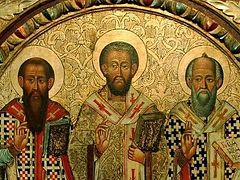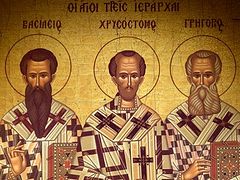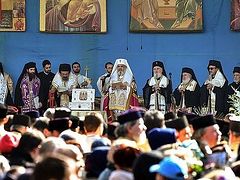 The Orthodox Church commemorates the ecumenical teachers and hierarchs Basil the Great, Gregory the Theologian and John Chrysostom on January 30/February 12. Since its Ottoman occupation, Greece has marked this date as the Day of Education and Enlightenment, the feast of all those who teach and those who are taught, widely celebrated in universities. Russia’s churches and theological schools observe the feast with a traditional and unusual rite, which includes many prayers and hymns being read and chanted in Greek.
The Orthodox Church commemorates the ecumenical teachers and hierarchs Basil the Great, Gregory the Theologian and John Chrysostom on January 30/February 12. Since its Ottoman occupation, Greece has marked this date as the Day of Education and Enlightenment, the feast of all those who teach and those who are taught, widely celebrated in universities. Russia’s churches and theological schools observe the feast with a traditional and unusual rite, which includes many prayers and hymns being read and chanted in Greek.
The Three Holy Hierarchs lived in the fourth to fifth centuries, at the crossroads of two fundamental cultures, the Antique and Byzantine, playing pivotal roles in shaping the minds of the entire Roman Empire. They witnessed the fourth century, which was a turning point for Christianity and saw a clash between the Christian and the pagan traditions. They witnessed the dawn of a new era, which put an end to the spiritual seeking of late antiquity. The old world was transformed in troubles and struggles. Decrees on religious tolerance were issued consecutively in 311 and 325, and offering sacrifices was prohibited in 341. Heathen temples were closed, and in 351 people were banned from attending them on pain of death or seizure of property. However, all these measures proved to be futile to the notorious pagan life, its pagan temples and teachers would again pervade in the country once one left a church. The empire was imbued with paganism, similar to a living corpse; it began to rot as the supporting hand of the state cut off its support (381). Palladas, a heathen poet, wrote, “If we are alive, life itself is dead”. This was an epoch of a universal worldview of chaos and of extremes, rooted in searching for a new spiritual ideal in mystical eastern cults of the Orphics, Mithraists, Chaldeans, Gnostics, in the Neoplatonist’s philosophy of pure reason, or in the religion of hedonism promoting boundless carnal pleasure. Everyone was up to choose his own path. This epoch was very similar to the one we live in today.
This was the time when the Three Holy Hierarchs happened to preach the religion of self-denial, asceticism and moral values; and were among those who made decisions concerning the Holy Trinity to fight against the heresies of the fourth century, interpreted the Holy Scriptures and delivered passionate speeches on the commemoration of martyrs and Church feasts, played an active part in community service, and were heads of dioceses in the Byzantine Empire. Up to the present day, the Orthodox Church celebrates liturgies that are centered upon the Anaphora (the Eucharistic canon) composed by Sts. John Chrysostom and Basil the Great. Both in the morning and in the evening, we read prayers that Sts. Basil the Great and John Chrysostom offered to God. Students, as well as alumni, of the Department of Classics can happily recollect that Sts. Gregory the Theologian and Basil the Great studied classics and rhetoric in Athens and that they were best friends. St. Gregory would humorously say, “Seeking knowledge, I found joy... having experienced what Saul did when he had been looking for his father’s donkeys, but found the kingdom.” The Three Holy Hierarchs laid the foundation for a new literary tradition and were among those who looked for a new poetic form. Later, other authors drew inspiration from their works. For example, the first irmos of the Nativity canon by St. Cosmas of Maiuma (eighth century) reads, “Christ is born; glorify Him! Christ comes from heaven; meet ye Him! Christ is on earth; lift up your hearts! Sing to the Lord, O earth!...” We can hear the irmos during the Nativity Fast, a time of preparation for the feast, but it was borrowed from St. Gregory the Theologian’s Theophany sermon. The saints’ names perfectly define them: “the Great” implies his greatness as a teacher, a mentor, theorist; “the Theologian” alludes to the fact that he was a divinely inspired poet of misfortune and suffering and a theologian of life rather than a dogmatist (given the entire Christian history, only three saints were vouchsafed to be called Theologians: Christ’s beloved disciple John the Theologian, St. Gregory and St. Symeon the New Theologian of the eleventh century). The name Chrysostom suggests the golden mouth of an ascetic labourer and a martyr, a shrewd and zealous speaker, a gifted and brilliant person. The lives and works of the Three Holy Hierarchs are instrumental in understanding how the legacy of antiquity was intertwined with the Christian faith in the minds of the Roman academic elite, how the unity of faith and mind, scholarship and erudition was achieved without any contradiction to true piety. In no way did the hierarchs reject secular culture, but insisted that everyone know it “after the manner of bees”, for the bees do not visit all the flowers without discrimination, nor do they seek to carry away entire those upon which they light, but rather, having taken so much as is adapted to their needs, they let the rest go (Basil the Great, Address to Young Men on the Right Use of Greek Literature).
Though the Three Holy Hierarchs lived in the fourth century, their widespread commemoration together began much later, in the eleventh century. Each of them was commemorated even before this date, but the following occurred in the eleventh century. According to a story that we find both in the Greek and Slavic Menaions for January 30, a dispute over the importance of the Three Holy Hierarchs erupted among “the most educated and eloquent men'” of Constantinople, the capital of the Byzantine Empire. It was during the reign of the Byzantine Emperor Alexios I Komnenos. Some claimed St. Basil was the greatest, some said it was St. Gregory the Theologian, some St. John Chrysostom. Then the Three Holy Hierarchs appeared in a dream to John Mauropous, Metropolitan of Euchaita and a prominent hymnographer of the time (today we have about two hundred canons of his in manuscript form and read his Canon to the Guardian Angel prior to Communion). They said they were equal before the Lord and suggested he unite their three commemorations into one feast and compose a service and hymns for it. Thereafter, John Mauropous composed the service of January 30, as all three were commemorated in January: St. Basil the Great on January 1, St. Gregory the Theologian on January 25, and the Translation of the Relics of St. John Chrysostom on January 27. This story seems doubtful for some experts. We do not find it in other Byzantine texts. Furthermore, it is unclear whether John Mauropous was still alive during the reign of Alexios Komnenos. Nevertheless, the story is embedded in the treasury of the Church Tradition.
The Three Holy Hierarchs in Byzantine Literature
The Three Holy Hierarchs were Byzantium’s most beloved and venerated primates. Ancient sources we have—both those of literature, fine arts and liturgy—say that they were inseparable from each other by the tenth-eleventh centuries. The book The Miracles of St. Gregory speaks about a story of a Saracen who saw Christ offered as a sacrifice during the Divine Liturgy in a renowned St. George Church in Ampelonas. When the Saracen condemned the priest for murdering a child, the latter returned that even “the great and glorious fathers, the luminaries and teachers of the Church—holy and great Basil, the sublime Chrysostom and Gregory the Theologian—had not seen that terrible and forbidding mystery.” In his Sermon Against the Heretics and Instruction From the Books of God, a Bulgarian clergyman Cosmas the Presbyter (late tenth century-early eleventh century) wrote the following: “Be followers of those who lived before you; I mean the Church fathers, bishops Gregory, and Basil, and John, and others, who were of the same rank as you are. Their sorrows for and griefs over people are innumerable.” The Three Holy Hierarchs were of outstanding importance for John Mauropous; he dedicated The Praise, epigrams and two hymnographical canons to them. In the following centuries, illustrious writers and prominent Church primates tirelessly remembered the Three Holy Hierarchs in their works: for instance, Theodore Prodromos (twelfth century), Theodore Metochites, Patriarch Nikephoros I of Constantinople, Patriarch Germanus I of Constantinople (thirteenth century), Patriarch Philotheus I of Constantinople, Matthaios Kamariotis, Bishop Philotheus of Selymbria, Nicholas Kabasilas, and Nikephoros Kallistos Xanthopoulos (fourteenth century).
The Three Holy Hierarchs in Liturgical Texts: Menaions, Synaxaria, and Typikons
Greek service books have marked the commemoration of the Three Hierarchs since the early eighth century. For instance, the Rules of the Greek Pantokrator Monastery (1136), founded by Emperor John II Komnenos and his spouse Irene, mentions the service of a church consecration on the day of “St. Basil, the Theologian and Chrysostom”. Across the world, there are about twenty handwritten menaions from the eleventh to fourteen centuries, containing services to the Three Holy Hierarchs. Some of them also include The Praise; Mauropous and two menaions of the fourteenth century include the synaxaria.
Images of the Three Holy Hierarchs
The first images of the Three Holy Hierarchs date back to the eleventh century. One of Mauropous’ epigrams describes an icon of the three saints that was gifted to Bishop Gregory. The typicon of the Theotokos Kecharitomene Monastery, founded by Empress Irene in the twelfth century, mentions another icon.
We find the most ancient image of the Three Holy Hierarchs in the Psalter, compiled in 1066 by Theodore, a writer of the Constantinople Monastery of the Studion, which is now in the British Museum. A miniature painting in the Lectionary (a book of Scripture reading) from Dionysiou Monastery depicts the hierarchs in front of a host of saints and dates back to the second half of the eleventh century. During the reign of Konstantinos Monomachos (1042-1055), the first frescos of the Holy Hierarchs, dressed in their episcopal vestments, were painted on the altar apses in the churches—for example, in the Church of St. Sophia in Orchid (1040-1050), and in the Palatine Chapel in Palermo (1143-1154). As the Synaxarion legend of the fourteenth century became increasingly popular, a unique iconographic image was created: The Dream of John Mauropus, displaying John of Euchaita before the Holy Hierarchs seated on the throne in the Hodegetria Church in Mystras (Peloponnese, Greece). The church frescoes were painted, admittedly, in 1366.
The Three Holy Hierarchs in the Slavic lands
The feast of the Three Holy Hierarchs was added to the Orthodox calendars of the south Slavic, Bulgarian and Serbian Churches in the early fourteenth century, and to the ancient Russian calendars in late fourteenth century. The Praise by Mauropous and the festive service were brought to Southern Europe in the early fourteenth century and to Russians in the late fourteenth to early fifteenth centuries. At the same time, Russia saw their first icons: for example, the Pskov icon of the Three Holy Hierarchs and St. Paraskeva (fifteenth century). The Russian Orthodox Church began to consecrate churches in commemoration of the Three Holy Hierarchs at the crossroads of the fourteenth and fifteenth centuries (the first Church of the Three Holy Hierarchs “On Kulichki” was constructed in 1367).
On the Feast’s Origin
The epigrams and canons, composed by John Mauropous, speak about the equality of the Holy Hierarchs, their promotion of the Church dogmas, and their rhetorical gifts. The Holy Hierarchs were likened to the Holy Trinity and they proved the true teaching about the Holy Trinity: “In the Holy Trinity, evangelize thrice the Father, Who was not begotten, and the begotten Son, and the proceeding Spirit.” They defeated the heresies; and brazen heretical teachings vanished, “as wax melts before the fire” of the Hierarchs’ speeches. Both The Praise and the canons illustrate the Holy Hierarchs as a kind of a dogmatic armor of the Orthodox Church; the author named their teaching a “third testament”. We can view their reference to the Holy Trinity in the context of the Schism of 1054, when the Ecumenical and the Western (Catholic) Churches broke communion with each other. The Filioque (“and from the Son”) was a new term added by the Catholics to the Creed. The canons and The Praise underscore that the saints did their best to preserve the Church; they insisted that heresies come to an end. Their works mention the “numerous labors and illnesses” they suffered for the Church, “fighting against the East and the West”. This means that they used their theological works to instruct the stray advocates of the Western Church and members of the Church who misunderstood the Holy Trinity. A solution to the problem is rooted in the polemics between the Western and Eastern Churches, the so-called anti-Latin polemics of the eleventh century. Authors of the anti-Latin polemical statements often proved their point by quoting the Three Holy Hierarchs and accusing the Western Church of not venerating them. Michael I Cerularius, Patriarch of Constantinople, wrote the following about the Latins in his letter to Patriarch Peter of Antioch: “Our holy fathers and teachers, Basil the Great, Gregory the Theologian and Chrysostom, are not venerated as saints, nor is their teaching accepted [by the Latins].” Both works by Metropolitan George of Kiev (1062-1079) and an address of Metropolitan Nicephorus of Kiev (1104-1121) to Vladimir Monomakh accused the Western Church of its disrespect of the Church fathers and the teaching of the Church. The author of The Tale by Symeon of Suzdal of the Eighth Council (of Florence) of 1439—which proclaimed the Union of the Eastern and Western Churches—compared St. Mark, Metropolitan of Ephesus who defended the Orthodox position, with the Three Holy Hierarchs. The Tale says, “If only you could have seen the glorious and holy Mark, Metropolitan of Ephesus, speak to the pope and all the Latins, you would have been crying for joy and rejoicing, as I did. You see the glorious and holy Mark of Ephesus; John Chrysostom, and Basil of Caesarea, and Gregory the Theologian lived before him, but now St. Mark is similar to them.”
Therefore, the image of the Three Holy Hierarchs, which arose from the depths of national veneration, was shaped and added to the Church liturgical year in Constantinople’s court circles in the third part of the eleventh century as a strategy for combating the West. The Church considered the Three Hierarchs to be a firm foundation of the Orthodox faith, critical during those spiritual disputes and troubles. Their own fight against the fourth century heresies was instrumental for the Church of the eleventh century. Therefore, the feast was introduced, the canons, epigrams, and Praise were composed by John Mauropous, and their first icons emerged. Besides the story that ended the disputes concerning the hierarchs’ rhetorical gifts, this was probably an additional impetus for introducing the feast of the Three Holy Hierarchs in Byzantium of the eleventh century, during the reign of Alexios Komnenos.



